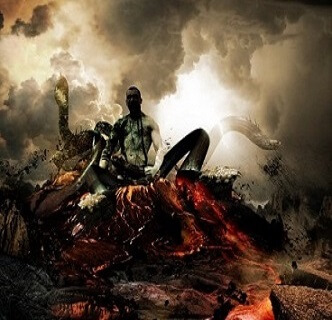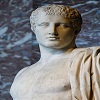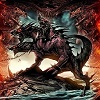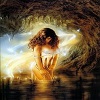Typhon
Father of All Monsters
Known as the "Father of All Monsters", Typhon was believed to be the most deadly monster of Greek mythology.
His human upper half supposedly reached as high as the stars, and his hands reached east and west.
Instead of a human head, a hundred dragon heads erupted from his neck and shoulders.
There are gods, and there are monsters, but rarely are there gods that are also monsters. In Greek mythology, there is no god/monster as powerful, dangerous, and downright deadly as Typhon.
He is called Typho, Typhaon, Typheous, Typhos, and Typhon in Greek mythology, but regardless of which name is mentioned, it's not hard to figure out who is being talked about. Most often described as the most horrifying and powerful monster in legend, no beast or demon was as feared by the gods as was Typhon in Greek mythology.
He is described in many different ways, varying slightly from legend to legend, but aggregating the most popular descriptions gives us this image of the beast:
He was a giant - so tall his head touched the stars. He had the torso of a man, but each leg was an enormous viper coil that writhed and hissed as he moved. He had a main head that hosted 100 snake heads that constantly screamed the sounds of various animals. All that is described of his human-like head are glowing red eyes that drove fear into the hearts of all that looked upon them, and a "savage jaw" that breathed fire. He had hundreds of wings all over his body, and instead of ten fingers his hands were made of 100 deadly serpents.
Typhon, in Greek mythology, was not just a monster. He was also a god - the last child of Gaia (the Earth) and Tartarus (a violent and bottomless storm pit) who were both considered gods. Some myths say he was instead the child of Hera (Greek mythology), but a better explanation comes from a story where Hera, in a fit of anger toward Zeus (Greek mythology) goes to Gaia and Tartarus and beseeches them to create a god more powerful than Zeus. Thus, Typhon is born and Hera gets a little more than she bargained for.
The Battle For Olympus:
The most famous legend involving Typhon in Greek mythology was when the monster god decided that he was tired of being an outcast and was going to take over Mount Olympus, home of the gods. Naturally, Zeus (Greek Mythology) was not exactly thrilled with this idea and decided to stay and battle Typhon. With the exception of Athena, all of the other Greek gods and goddesses fled the scene, opting to change forms and hide from the monster rather than try to fight him.
Different versions of this legend have different details about exactly how the fight goes down, but all agree that it was long and drawn out. In the end, Zeus flings Typhon back into Tartarus (Greek Mythology) and throws Mount Etna on top of him, forever trapping him under its weight.
Being the fire-breathing monster he is, Typhon is believed to constantly struggle to become free, causing earthquakes and volcanic eruptions each time he moves.
[1]
Battle of Zeus and Typhon
Typhon was the last child of Gaia. After the defeat of his brothers Gigantes, Gaia urged him to avenge them, as well as his other brothers, the Titans.
Typhon started destroying cities and hurling mountains in a fit of rage. In the panic fear of Typhon, the gods fled to Egypt, where, in order to hide, they turned into a variety of animals: Zeus into the ram (leader), Hera into the cow, Aphrodite into a fish, Hephaestus into the ox, Heracles into a bird ibis. Only Athena stood on Mount Olympus, and she began a rebuke of Zeus because of cowardice, untill he again took his real face. Others say that Zeus and Athena bravely greeted Typhon.
Armed with his thunderbolts and steel sickle, Zeus chased Typhon all the way to Syria. When he managed to wound him, Zeus was engaged in combat with him.
However, Typhon has proved to be a worthy opponent, and although wounded, managed to take steel sickle and to cut Zeus' tendons of the hands and legs. So he captured Zeus and entrusted his tendons to the dragon Delphyne. However, Hermes and Egipan managed to steal the tendons and return it to Zeus, who again attacked Typhon. Typhon threw rocks at Zeus, but the ruler of the gods blocked them with thunderbolts.
The rocks returned to Typhon causing him serious wounds. Finally, Zeus threw Mount Etna at Typhon.
[2]
Children of Typhon:
Typhon, in Greek mythology, was married to the half-woman half-serpent Echidna, and together they bore some of the most horrifying creatures in all of mythological history.
Gorgon - the snake-haired and snake-bodied humanoid that was created in its mother's image. Its stare could turn a person to stone. Medusa became one of these creatures in a later myth.
Cerberus - the three-headed dog that guards the entrance to Hades.
Chimera - Part-lion, part-goat, part-snake - all monster.
Sphinx - the half-human, half-lion that forces those its meet to answer its riddles, or die.
Hydra - the nine-headed serpent who grew two new heads for every one that was cut off.
Nemean Lion - the giant lion with impenetrable hide who becomes the constellation Leo.
Orthros - the two-headed dog that lived with giants.
Ladon - the snake that guarded the golden apples in the Garden of the Hesperides.
[1]












